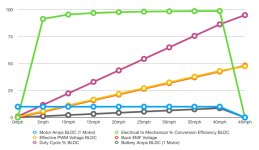Two scenarios:
1. 60V 70A battery current 70A phase current
2. 60V 70A battery current 100A phase current
Assuming that I'm cruising at top speed meaning 60V*70A=4200W
Now my problem is with example #2 where the phase current is higher than the battery current.
The total power going from the controller to the motor cannot be higher than what the battery outputs.
So, if the current in the phases is 100A then the voltage inside the motor cannot be equal to battery voltage (60V) but has to be 42V (4200W/100A phase current) meaning that if all of this is true then I would always limit my speed when the phase current is higher than the battery current.
In practice I don't see that happening so I'm probably wrong here but I would like to know why my vesc draws 100A phase while my battery current is at 70A.
1. 60V 70A battery current 70A phase current
2. 60V 70A battery current 100A phase current
Assuming that I'm cruising at top speed meaning 60V*70A=4200W
Now my problem is with example #2 where the phase current is higher than the battery current.
The total power going from the controller to the motor cannot be higher than what the battery outputs.
So, if the current in the phases is 100A then the voltage inside the motor cannot be equal to battery voltage (60V) but has to be 42V (4200W/100A phase current) meaning that if all of this is true then I would always limit my speed when the phase current is higher than the battery current.
In practice I don't see that happening so I'm probably wrong here but I would like to know why my vesc draws 100A phase while my battery current is at 70A.


